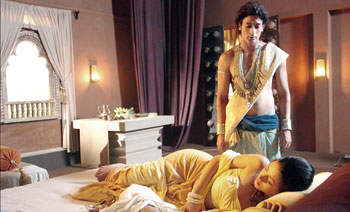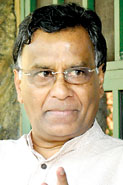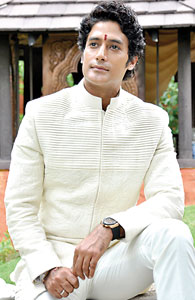Siddhartha: The making of a story, not a moral lecture
View(s):By Duvindi Illankoon, Pic by Susantha Liyanawatte
The closing credits are rolling and there is not a dry eye in the audience. “I never expected to feel sorry for Siddhartha,” remarks an audience member and nothing could ring more true. Sri Siddhartha Gautama is not what one expects of a ‘Buddhist film’; it is not a moral lecture, neither is it a philosophical ramble. Rather, it is the story of one man’s sacrifice for humanity.

A still from the movie
For Production Designer and Producer Navin Gooneratne -the making of Sri Siddhartha Gautama was perhaps the most trying challenge of his life. Camera teams walked out and he had to mortgage his assets to make the project a reality, yet he stood strong. As close friend and the film’s set designer Roshan Chandrarathne put it ‘Navin was the calm in an ocean of turbulent waters’.
As the Chairman of the Light of Asia Foundation, Mr. Gooneratne’s aim was taking the message of Buddhism to the world. “When the initial idea for the film cropped up I knew it wasn’t going to be easy,” he says. “Making an epic about the early life of the Buddha was not something that could be taken in a light vein.”
Together with Director Saman Weeraman he set about finding a suitable script. Many scripts-some even written by Hollywood professionals-were proposed and discarded. “What we were looking for was something that was very emotional,” he explains. “I wanted this film to be all about the emotions and the character. Not filmy glitz and glamour.” Frustrated with the choices on offer they decided to do the script themselves, with assistance from Edwin Ariyadasa and George Paldano, and advice from the Maha Sanga.
The Maha Sanga played an important role in the scripting of the film. Their only advice to the writers was to dispel the popular myth of Siddhartha ‘sneaking away’ from the palace in the dead of the night. “If you read about the character you realise that a man of such integrity wouldn’t just sneak out of the palace without the blessings of his wife and family,” remarks Gooneratne. “The only advice the Maha Sanga had was for us to set that story straight. They said, ‘if you think what you’re doing is right, if you know that you’re doing this with no ulterior motive then you must do whatever you think suits’. That was their blessing.”
Garnering support for the venture also proved a challenge. The initial budget of the entire production was a mind blowing Rs.200 million (later, compromises were made). The staggering costs kept investors at bay- “It was difficult to convince people to come on board,” says Gooneratne. “But somehow, I knew that things would work out.”
Gooneratne recounts an unexpected experience he had when he was about to go in for a meeting with the Board of Investment. “I was at the car park and had stopped the vehicle at security. I had all the production files on my lap, and while I was parked a bo leaf floated into the car and fell onto the file,” he pauses, and smiles. “It sounds strange but at that moment I knew this film was definitely going to be a reality.”
From then on the team had the confidence to go on. Set construction began in Thalangama (near Pelawatta) and Manelwatta in Kelaniya. Architect Roshan Chandrarathne worked with about Rs. 60 million to construct the towering palaces of the Shakyas, along with other miscellaneous structures.

Navin Gooneratne
For Chandrarathne, the challenge lay in dreaming up Kapilawasthu, the kingdom of the Shakya clan. “All the stories we have heard about Kapilawasthu and Lumbini comes from oral history. Nothing has really been documented. We really had nothing to go on, except what has been written in recent years by archaeologists. I remember being frustrated because the set needed to be done before everything else and I hadn’t the faintest idea of what it should look like.” Then one night, the answer came to Chandrarathne in a dream. “I was walking through a tree-lined path to a great palace,” he remembers. “The next morning I woke up and set pencil to paper.”
He was still unsure if this was to be the great palace of Kapilawasthu. Visiting Chief Archaeologist of Kapilawasthu and Lumbini, one Mr. Basantha Bidhari, put all doubts to rest. “He happened to see the sketch,” he smiles. “He was told it was mine -he came up to me and clasped both my hands in his. He had tears in his eyes.” The archaeologist went on to show him a book that had been written about the structures of ancient Kapilawasthu -the descriptions matched the sketches almost word to word.
With the sets under construction, Gooneratne and Weeraman turned their attention to the main task at hand-casting the actors. Perhaps one of the most frequent criticisms of the film is the use of Indian actors for the main roles. For Gooneratne and his team, the reasoning is rather obvious. “We searched high and low for Sri Lankan actors that would bear a physical resemblance to the characters, but found none,” explains Gooneratne. “Then we made the decision to cast the main roles from India.” One can’t dispute their choices; Gagan Malik and Anchal Singh are pitch perfect in their roles as Siddhartha and Yashodhara. “We wanted someone who was a true Siddhartha in character. The first time we met Gagan, Saman and I both knew he was the one for the role,” enthuses Gooneratne. “It was in his eyes.”
Many have asked why the film focuses on the life of Siddhartha up to that pivotal moment of enlightenment, and not afterwards when the story gains more substance. “It’s important that one understands what led up to Siddhartha’s decision to leave behind the material in search of the truth,” explains Gooneratne. “This is not a film on Buddhist philosophy. It’s a film about the individual, the Buddha himself. Most Buddhists, as well as non-Buddhists are aware of the teachings of Buddha. A fundamental teaching is to accept nothing without questioning its credibility first. Buddha himself said that a follower must question his own teachings before accepting them. I believe that a fundamental part of understanding Buddha’s teachings is to know the story behind those teachings.”
Sri Siddhartha will be dubbed in several Asian languages, as Gooneratne laughingly adds, ‘Asians don’t like reading subtitles while watching the film!”. The Western screenings, however, will not see the film being dubbed in English. Instead the original will be subtitled. The magnificent sets in Thalangama and Manelwatta are now open to the public-pay a visit and you’ll find most of the costumes and weapons used in the film on display as well.
“I want people to know that this is not just a film. It’s a message that we’re gifting humanity with; a message of compassion, understanding and love,” says Gooneratne. In these turbulent times of religious strife and discord, that’s certainly a message us Sri Lankans would do well to embrace.
Sri Siddhartha Gautama was produced by Navin Gooneratne and Jeff Gunawardena. The film was directed by Saman Weeraman, with advice from Chandran Ratnam. The film stars Gagan Malik, Anchal Singh, Ranjan Ramanayake, Anshu Malik, Anjani Perera, Gautam Gulati, Saranga Dissasekara, Buddhadasa Withanachchi and Roshan Ranawana.
Gagan Malik, the man made for the role
He’s calm and at ease, even though he needs to get to the airport and we’re holding him back for the interview.
Indian actor Gagan Malik who won the adulation of many local movie-goers for his portrayal of Prince Siddhartha in the locally produced epic Sri Siddhartha Gautama is seated calmly in the peaceful back garden of the Light of Asia Foundation’s Sama Centre; this is an actor who has embraced his character rather more intensely than most.
Perhaps it’s a natural reaction. This is a role he has coveted since 2005 -well before the local version was even conceptualised. An Indian director had been asked to direct a Hollywood version of the story and Malik was aware of the role. “Unfortunately, I was still in Europe and it didn’t come to anything.”
When he heard about casting for this film in late 2011, he decided to give it a shot. The competition was by no means inconsiderable-over 300 young actors auditioned for the role of Prince Siddhartha. That first interview took him by surprise. “Mr. Navin Gooneratne (Producer and Production Designer) kept asking me all sorts of questions about myself-everything except acting!” he laughs. Mr. Gooneratne later went on to add that he and Director Saman Weeraman knew Malik was ‘the man for the role’, despite reservations from certain ends.

Gagan Malik
As a native Indian speaking Hindi, Malik had a tough time learning an entirely new language– Sinhala. He adds that speaking the language was not the problem-it was rather the communication of it. “It’s easy to learn the words and repeat it. But when you’re acting, you have to get the pronunciation pitch perfect. Sure, our lines were dubbed over, but we still had to seem as if we were saying it using the same intonation. The toughest aspect was in getting those all important pauses right,” he says.
“There were those who felt that I was not right for the role,” says Malik, adding that it was all a matter of having the confidence and commitment needed to play such a momentous role. “But after we shot for the first time, people came up to me and said they didn’t believe in me at first, but they were happy to be proven wrong. Everything that I did in the film was natural-there were no special effects, even in the scene where I had starved myself while meditating. I had to lose 8 kilos for that scene. And then I had to grow a beard- that was itchy beyond belief!”
Filming was not all roses, says Malik laughingly adding that actually, the thorns were rather literally predominant. “When I walk through the forest in the film, I can’t look down because obviously it wouldn’t look very cinematic if I kept glancing down at my feet. It was torture-at the end of each day of filming my feet would be bruised and bloodied and a doctor was on set to deal with that.”
Malik has been in Sri Lanka these past few weeks, touring the country and meeting fans. “The feeling you get, when you go somewhere and people come over to speak to you and tell you that your role changed their lives-that’s amazing,” he says just before he rushes off to catch his flight back to another life in India and another role as Ram in Ramayan. “ It may be cliché, but that’s why this role has changed my life.”
Follow @timesonlinelk
comments powered by Disqus


















